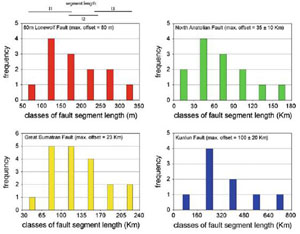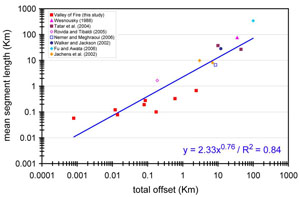| |||||||||
|
|
|||||||||
|
|
|||||||||
| Fault Segment Length Distribution | |||||||||
|
Since faults in the brittle regime grow in length through linking with adjacent faults by splay fractures, large faults are almost always broken into segments. For a given total fault length, the length of segments may follow a log-normal distribution (see 'Fault Segment Length Distribution'). The mean segment length is proportional to the total length of the fault. de Joussineau and Aydin (2009) investigated the length of fault segments on several strike-slip faults with varying slip in Aztec sandstone at Valley of Fire State Park, Nevada. They show that the segment length of a fault may follow a log normal distribution, with the highest frequency segment length roughly equal to the maximum slip (Figure 1). More than 70% of segment lengths are less than four times the maximum slip.
The authors also suggested a power law relationship between the maximum fault slip and the mean fault segment length (Figure 2) from the data collected at Valley of Fire Park, NV, as well as other data reported by various authors (Stirling et al., 1996; Otsuki and Dilov, 2005). Since fault length is one order of magnitude larger than the maximum slip, this figure indicates that the mean segment length is roughly 0.1 of the fault length.
| |||||||||
| Reference: |
|||||||||
| de Joussineau, G., Aydin, A., 2009 Otsuki, K., Dilov, T., 2005 Stirling, M.W., Wesnousky, S.G., Shimazaki, K., 1996 |
|||||||||
|
Readme | About Us | Acknowledgement | How to Cite | Terms of Use | Ⓒ Rock Fracture Knowledgebase |
|||||||||

